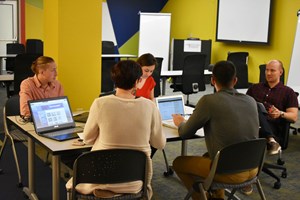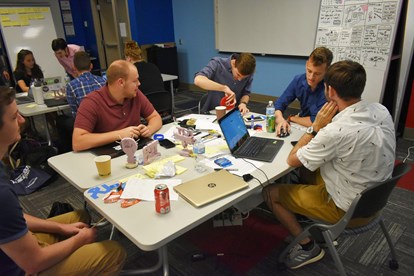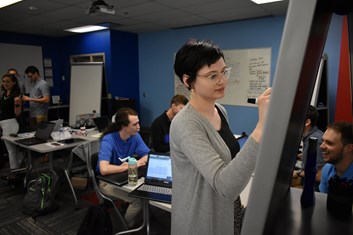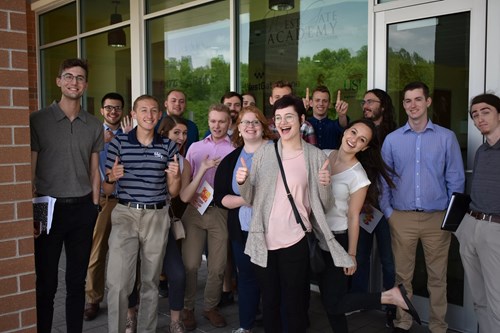
Sixteen of USI’s most promising problem solvers are in the middle of a sprint. It’s not the kind that happens on a track, though. This race starts and finishes on the second floor of downtown Evansville’s Innovation Pointe—and requires mind over muscle.
 “[We’re] basically learning different techniques of startup businesses and being an entrepreneur,” explains Justin Faas ’20, business administration, “the ideas of where it would start, how we would do it, who we would interview, what questions we would ask, and certain problems to solve.”
“[We’re] basically learning different techniques of startup businesses and being an entrepreneur,” explains Justin Faas ’20, business administration, “the ideas of where it would start, how we would do it, who we would interview, what questions we would ask, and certain problems to solve.”
It’s a design sprint—coached by Dr. Will Hawkins, assistant professor of kinesiology and sport and instructor at USI’s Technology Commercialization Academy, now in its eighth year. “They’re learning how to innovate in a systematic way,” Hawkins says. “You have to be able to build out an idea, prove that your idea is feasible at scale, and that it could actually be profitable.”
On a June afternoon, TCA participants—carefully chosen from a pool of close to 70 applicants—are practicing the method by developing potential business ventures meant to get more young people downtown: a dance club, a floating movie screen on the Ohio River and an app for students to use University meal plan money at off-campus restaurants. The point isn’t to turn every idea into a reality—it’s about quickly examining new products and services and determining if they’re worth pursuing.
Working in small groups, students use similar sprints as they attempt to achieve the program’s primary goal—finding new uses for existing military patents held by inventors at TCA’s partner, Naval Surface Warfare Center-Crane (NSWC Crane). “They have all of this knowledge and patents for military use, but a lot of the time they can be adapted for commercialized use,” says Katelyn Knoll ‘20, economics.

TCA faculty—including Hawkins, Dr. Art Chlebowski, assistant professor of engineering, and Dr. Jack Smothers, associate professor of management—along with Stephanie El Tawil, opportunity development coordinator in USI’s Outreach and Engagement, picked seven of Crane’s patents, or technologies, for students to explore. “This year we picked AR, augmented reality,” El Tawil says. “Some of it is directly applied, just in a commercial setting, and some is adjusting the tech to fit to the commercial need.”
In addition to AR, students are also developing commercial uses for wireless charging and a “smart” tourniquet that can measure someone’s vitals even when they’re not near a hospital. “I’m a product-minded person,” explains Hawkins. “[I enjoy] helping students see that they can actually build things that change people’s day-to-day lives.”
For 12 weeks, participants brainstorm, test and create at their own pace, alongside peers whose career paths are often very different than theirs. “When you get a graphic design person, an engineer, and an English person all together, you get so many different ideas than just being with your major all the time,” says Knoll. “I usually wouldn’t work with economics or web design or any of that,” adds Morgan Weddle ’20, advanced manufacturing. “It kind of helped [me] learn how to communicate and how to work with them as a team.”
“This is the best thing I could have done. It gets you into a different mindset of thinking and different ways to go around problems,” says Nicholas Scheller ’20, computer information systems. “The cooperation and teamwork between all 16 of us is a great thing to be a part of.”
 It’s also rewarding to watch. “They’re actively sharing skills. Nobody is forcing them to share these things—they’re just doing it on their own, and that’s beautiful,” says El Tawil. That’s so cool to see because that’s real life, and they’re building those skills here.”
It’s also rewarding to watch. “They’re actively sharing skills. Nobody is forcing them to share these things—they’re just doing it on their own, and that’s beautiful,” says El Tawil. That’s so cool to see because that’s real life, and they’re building those skills here.”
When TCA ends in late July, students will take those skills up I-69 to show the original patent holders at Crane their new, commercialization ideas. But the program isn’t just about professional development. “They’re taught to look at themselves introspectively and understand what they want to do and where they want to go,” El Tawil explains. “We encourage that a lot because we want to keep the talent in the region. That is our biggest goal. That is the whole point of this—to make sure that our top talent is staying in southwest Indiana.”